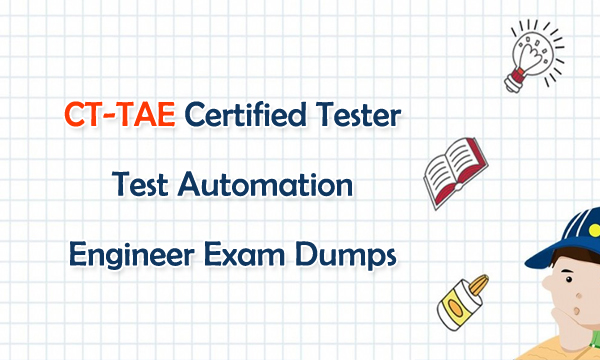CT-TAE Certified Tester Test Automation Engineer Exam Dumps
February 15,2023 02:00 AM
The latest Certified Tester Test Automation Engineer CT-TAE exam dumps have been cracked, which are the preparation material in preparation. ISTQB certification CT-TAE exam focuses on the design, development, and maintenance of test automation solutions. The CT-TAE exam also covers the concepts, methods, tools, and processes for automating dynamic functional tests, and the relationship of those tests to test management, configuration management, defect management, software development processes, and quality assurance.

ISTQB Certification CT-TAE Exam Structure
ISTQB Certification CT-TAE exam structure is available below.
Number of questions: 40
Exam Length (mins): 90 (+25% Non-Native Language)
Total Points: 75
Passing Score: 49
CT-TAE Certified Tester Test Automation Engineer Exam Objectives
The Certified Tester Test Automation Engineer CT-TAE exam objectives cover the following details.
Contribute to the development of a plan to integrate automated testing within the testing process
Evaluate tools and technology for automation best fit to each project and organization
Create an approach and methodology for building a test automation architecture (TAA)
Design and develop (new or modified) test automation solutions that meet the business needs
Enable the transition of testing from a manual to an automated approach
Create automated test reporting and metrics collection
Manage and optimize testing assets to facilitate maintainability and address evolving (test) systems
Practice Some ISTQB CT-TAE Exam Dumps
All the latest ISTQB Certification CT-TAE exam dumps are the best material for you to test the above Certified Tester Test Automation Engineer CT-TAE exam objectives. Share some ISTQB Certification CT-TAE exam dumps questions below.
1.You have inherited a TAS that is working well it uses keyword-driven scripting and was well architected. The automation architect who built the system has now moved on to another company. The TAS is working across several projects and has a multiple library of keywords, categorised by project. The individual project teams maintain these keyword scripts.Based only on the given information, what is the MOST significant risk for the TAS?
A. The level of abstraction, coupled with the departure of the architect may make the system hard to maintain
B. Because the keyword scripts are maintained by different teams, there is a likelihood that good coding standards are not followed
C. The keyword driven scripts may become out of date if not maintained
D. New projects may not work as well with the TAS as the current projects
Answer: A
2.Your company is new to test automation and as TAE. you have designed a TAS which successfully supports the SUT for the current project. There are other systems currently in operation which have been tested manually and more systems are planned over the coming years. Based on this success, your company requires test automation be rolled out to other current and future SUTs with consistency being a key objective. Which of the following is the BEST way to achieve that?
A. Design a new TAS for each SUT, and manage each one through a dedicated automation support team.
B. Check for correct connectivity to internal and external systems to ensure that the TAS has been installed and configured correctly for each SUT.
C. Install the current TAS into a central repository so that other tests on different SUTs use the same version of the TAS.
D. Develop a tool that keeps track of automation failures across the different SUTs and produces regular reports to stakeholders.
Answer: C
3.You have been asked to implement test automation for a project that is not meeting its deadlines. After further analysis you discover that the manual testers are not able to keep up with the new feature testing because the regression testing is taking 75% of their time. As a result, the new features are being released with many defects and customers are complaining about the quality.Given this information, what metric SHOULD you be tracking to show the value of test automation for this project?
A. Percentage of builds accepted/rejected by the automated tests.
B. Percentage of code covered by the test automation.
C. Equivalent Manual Test Effort for the automated tests.
D. Number of defects found by test automation.
Answer: C
4.What is the PRIMARY advantage of using abstraction in the TAA?
A. It improves the performance of the TAS
B. It ensures that any scripting method will be supported
C. It makes it more flexible for future reuse and improvements
D. It requires a higher skill level to implement
Answer: C
5.Which of the following statements about the reuse of TAS artefacts is TRUE?
A. To enable reuse of TAS artefacts, a good design for reuse is built into the TAA and to further action are needed during the TAS lifecycle
B. Reusable TAS artifacts associated with the definition layer of the TAA include the adaptors to the SUT components and/or interfaces
C. Reusable TAS artefacts can include components (or parts of components) associated with different layers of the TAA
D. Communications maintenance and improvements for reusing TAS artefacts are modify addressed during the design of the TAA
Answer: A
CT-TAE Exam Dumps PDF & SOFT | 1 Year Free Update | Money Back Guarantee
- Related Suggestion
- ISTQB Certified Tester Advanced Level Certification January 25,2021
- ISTQB-CTFL ISTQB-Foundation Level Exam Preparation August 04,2023
- 2020 Cracked CTFL-2018 Exam Dumps February 19,2020
- CTFL_SYLL_4.0 ISTQB Certified Tester Foundation Level Exam Dumps Online December 01,2023

